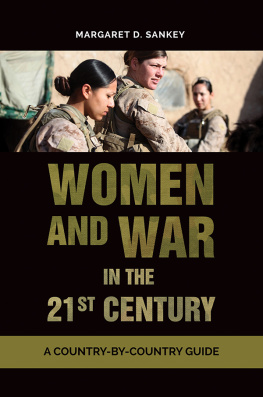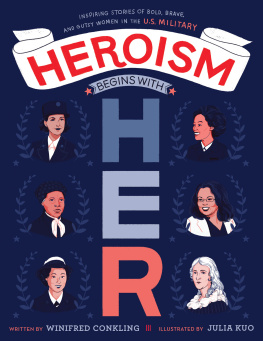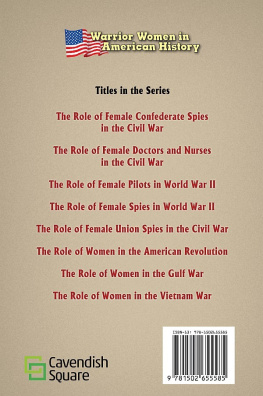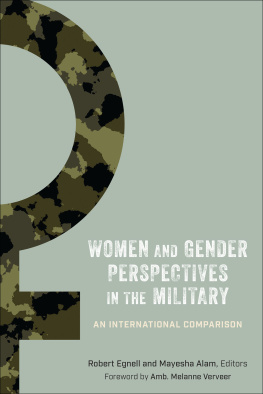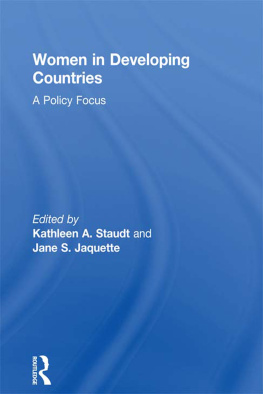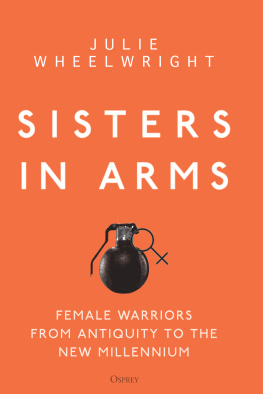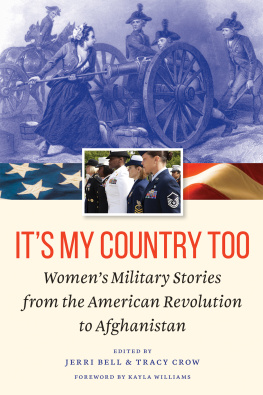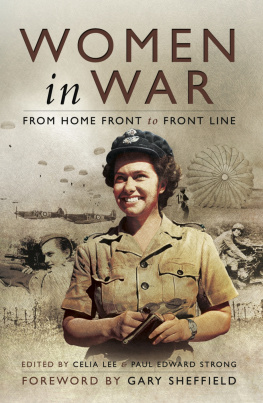Women and War in the 21st Century
A Country-by-Country Guide
Margaret D. Sankey

Copyright 2018 by ABC-CLIO, LLC
All rights reserved. No part of this publication may be reproduced, stored in a retrieval system, or transmitted, in any form or by any means, electronic, mechanical, photocopying, recording, or otherwise, except for the inclusion of brief quotations in a review, without prior permission in writing from the publisher.
Library of Congress Cataloging-in-Publication Data
Names: Sankey, Margaret D. (Margaret Diane), 1974- author.
Title: Women and War in the 21st Century : A Country-by-Country Guide / Margaret D. Sankey.
Description: Santa Barbara, California : ABC-CLIO, An Imprint of ABC-CLIO, LLC, [2018] | Includes bibliographical references and index.
Identifiers: LCCN 2018014307 (print) | LCCN 2018027725 (ebook) | ISBN 9781440857669 (ebook) | ISBN 9781440857652 (hard copy : alk. paper)
Subjects: LCSH: Women and war. | Women and the military.
Classification: LCC UB416 (ebook) | LCC UB416 .S36 2018 (print) | DDC 355.0082dc23
LC record available at https://lccn.loc.gov/2018014307
ISBN: 9781440857652 (print)
9781440857669 (ebook)
22 21 20 19 18 1 2 3 4 5
This book is also available as an eBook.
ABC-CLIO
An Imprint of ABC-CLIO, LLC
ABC-CLIO, LLC
130 Cremona Drive, P.O. Box 1911
Santa Barbara, California 93116-1911
www.abc-clio.com
This book is printed on acid-free paper 
Manufactured in the United States of America
Contents
Regional Guide to Entries
Africa (Sub-Sahara)
Eritrea
Ethiopia
Liberia
Nigeria
Sierra Leone
South Africa
East Asia and the Pacific
Australia
China
Japan
Korea
New Zealand
Philippines
Vietnam
Europe and Eurasia
Denmark
Finland
France
Germany
Great Britain
Greece
Hungary
Ireland
Italy
Norway
Poland
Russia
Sweden
Turkey
Near East
Algeria
Egypt
Iran
Iraq
Israel
Kurds
Libya
Palestine
United Arab Emirates
South and Central Asia
Afghanistan
India
Nepal
Pakistan
Sri Lanka
Western Hemisphere
Argentina
Brazil
Canada
Chile
Cuba
United States
Regions defined by the U.S. Department of State.
Introduction
Political scientist and feminist theorist Cynthia Enloe famously demanded of the field of international relations: where are the women? In speaking of women and war, they increasingly appear as heads of state and general officers formulating policy and as the uniformed ship captains, infantry platoon leaders, and fighter pilots carrying out their nations commands. At the same time, in a continuity from the earliest human beings, women are also the family members of combatants, the ones who care for the wounded and the dead, the residents displaced by conflict, and the labor that provides fighters with their food, clothing, and sexual release. Since the 1990s, what brought about this tremendous shift, in which large numbers of women have assumed recognized roles within the power structure, rather than as outliers and unsung supporters or acted-upon populations?
The end of the Cold War presented militaries, particularly those in the wealthy Global North, an opportunity to recalibrate their forces for the 21st century. With war planning no longer calibrating resources for a massive land war against the Soviet Union, their tax-paying and voting populations did not want to pay for conscription of a large standing army, and threats like the breakup of the former Yugoslavia did not respond to traditional military application of force. Military sociologists predicted the development of a postmodern military, in which planners would confront risks that recognized no national borders and in which nations would need to act, not necessarily out of their own Realist interests but in solidarity to preserve international peace and conduct humanitarian operations. In these situations, the warrior orientation of traditional militaries would be superseded by peacemaking and peacekeeping. From existing, limited inclusion of women into armed forces, experience suggested that the logistics, medical, diplomatic, and administrative skills of women might not just be acceptable in the new configuration but also particularly adapted to winning hearts and minds and conducting stability operations.
Meanwhile, international institutions increasingly recognized the role war was playing in the lives of women. Introduced in 1998 and law in 2002, the Rome Statute of the International Criminal Court specifically identified crimes against women (coerced prostitution, sterilization, trafficking, and forced pregnancy) during war as crimes against humanity and in some cases as genocide. This was in response to the mass rapes and sexual torture carried out in Rwanda and in the former Yugoslavia and represented a departure from the view that these offenses were against an individual and the honor of the family but were instead weapons.
The United Nations followed this with Security Council Resolutions 1325 and 1820. Resolution 1325, based on work done in the 1995 Beijing Platform for Action, recognized that conflict had a disproportionate effect on women and girls and called for all responses to take into account their presence. From preventing violation to supporting participation in ending the fighting, women and girls should be shielded from gender-based offenses; refugee camps should be planned with their needs in mind; disarmament, demobilization, and reintegration programs should be initiated with women assumed to be among the combatants; and women should be encouraged to take part in legitimate political processes following the peace. Countries supplying peacekeeping troops were to examine their recruiting and training and make it a point to increase the number of women deployed on these missions, and observers were tasked to specifically search out information on the experiences of women and girls during conflicts and make that information available. United Nations Security Council Resolution (UNSCR) 1820, issued in 2008, reiterates many themes of 1325 as well as the Rome Statute, in denouncing rape as a tactic of warfare and calling on governments and their militaries to take responsibility for protecting the civilian population and educating their forces about refraining from sexual coercion and violence. Despite lofty intentions, only 40 of the 192 signatories to 1325 have presented National Action Plans as of 2013, and the proclamations have had little effect on guerrilla forces or on harassment and assault within military organizations.
Nonetheless, many nations were proceeding with integrating their armed forces and opening all roles, including combat, to women. Part of this was outright necessity. Smaller families and shrinking populations meant that, in absence of universal male conscription, the only way to provide a quality pool of voluntary personnel was to invite women into the services most highly regarded and competitive jobs. A military competing with civilian employers could not restrict women to clerical duties when corporate airlines had women pilots or private security companies sent women as armed bodyguards. Women already regularly worked in nonmilitary jobs, requiring physical risk, long hours, and travel far from home, which were common arguments against military inclusion. Additionally, in the late 20th-century conflicts, having women among the soldiers, sailors, and airmen offered a sense of legitimacy and national commitment of the whole population lacking when the boots on the ground belonged entirely to men.

